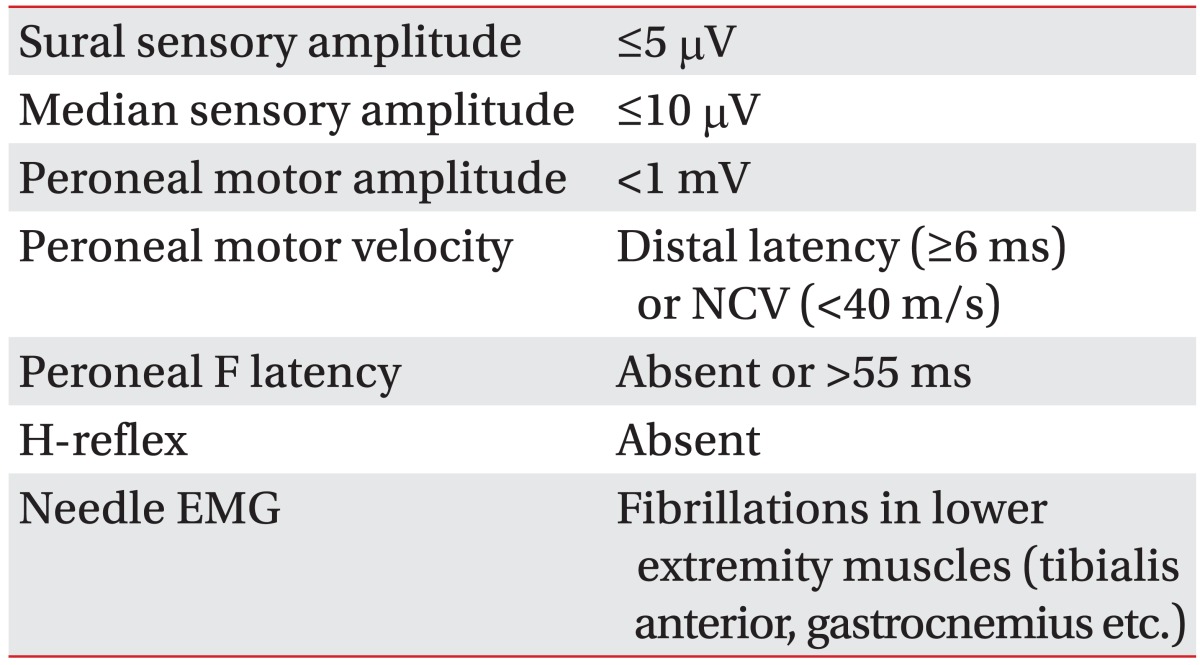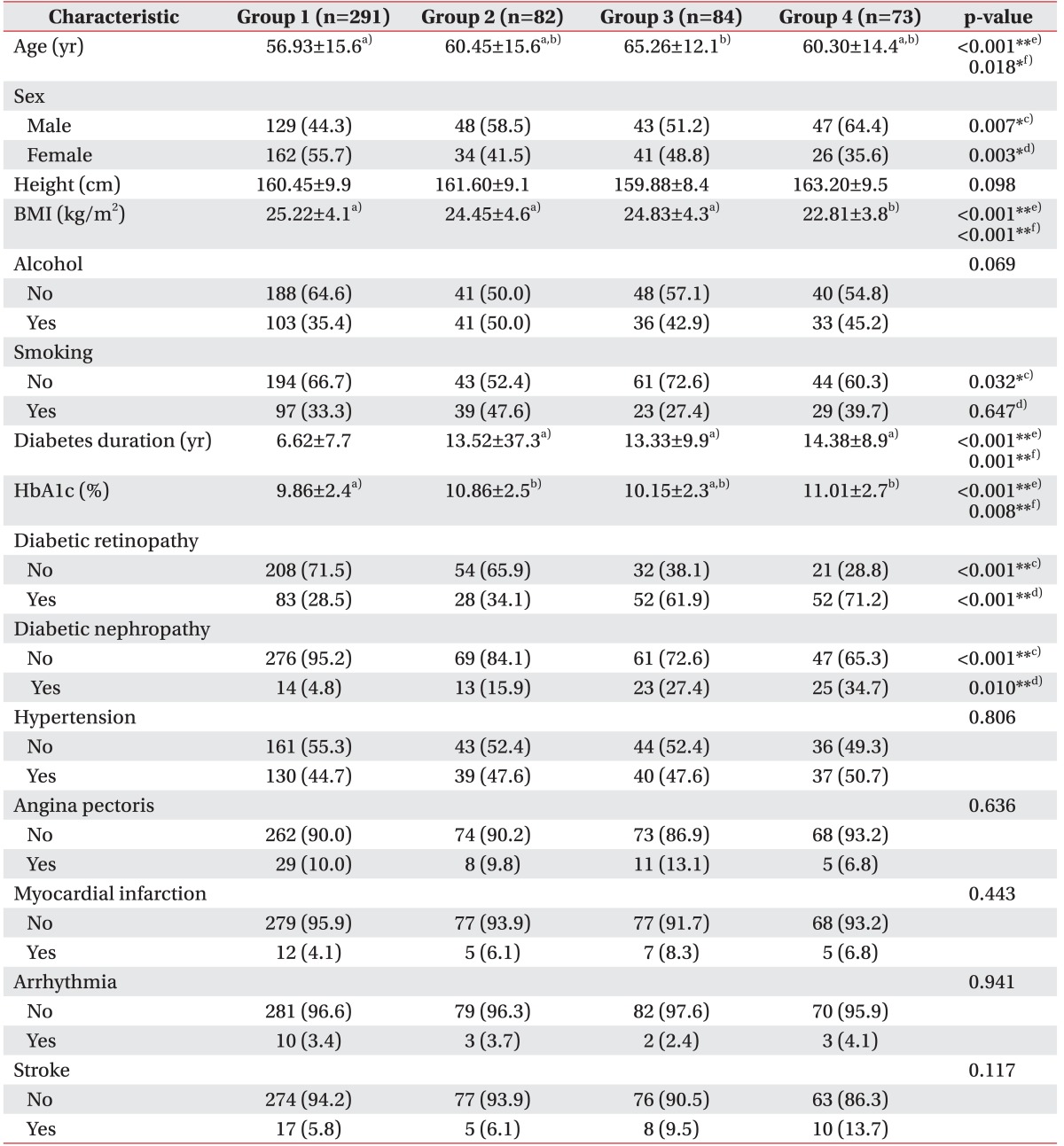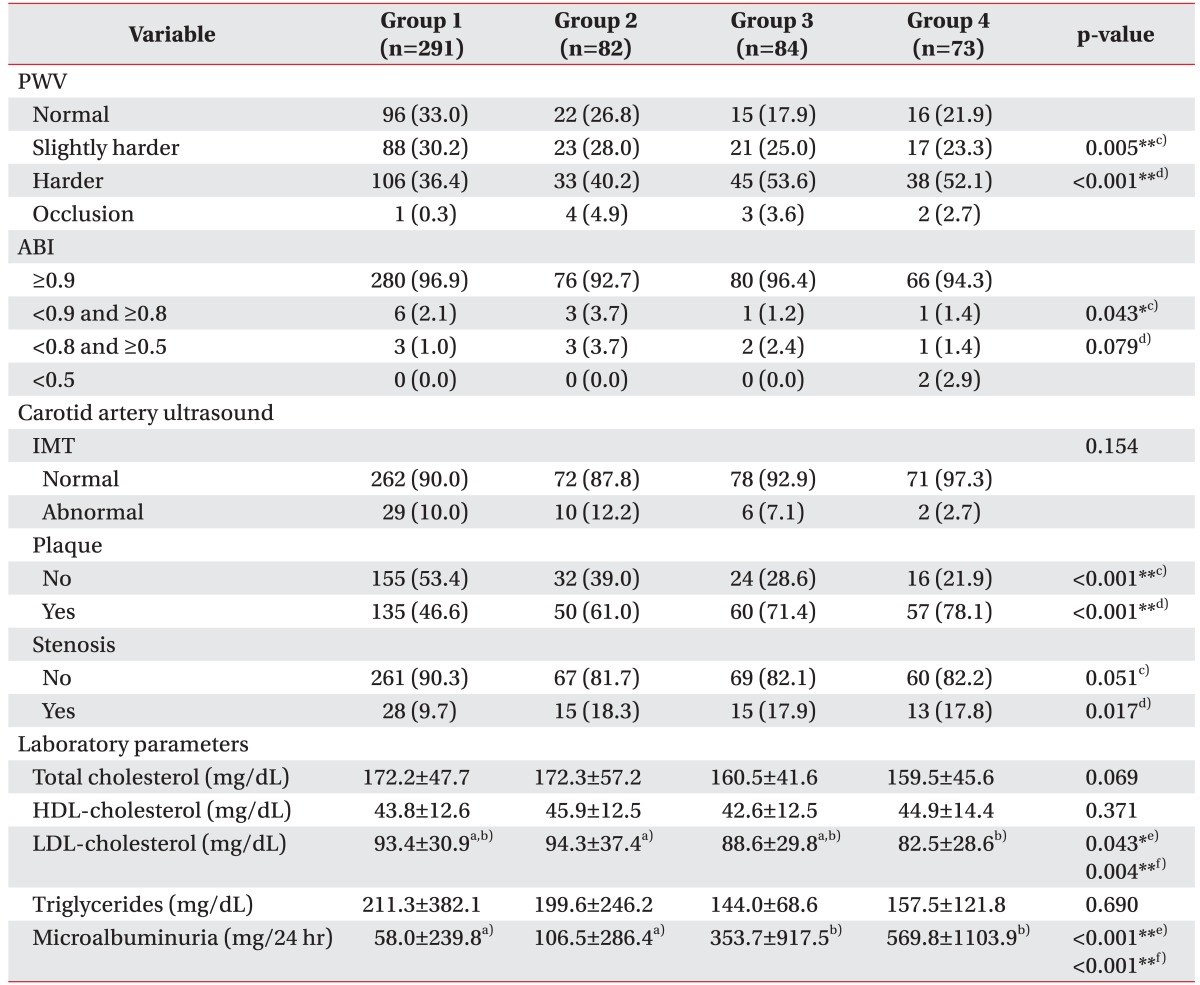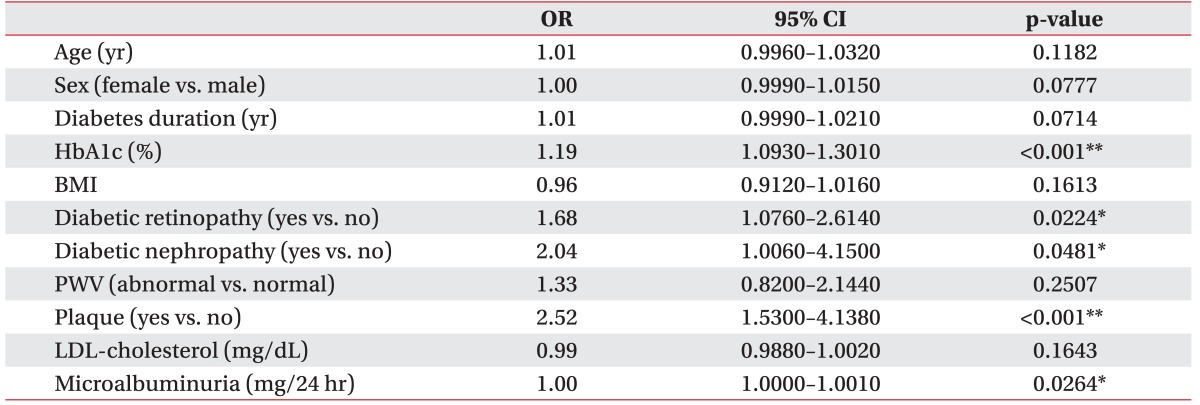1. Orchard TJ, Dorman JS, Maser RE, Becker DJ, Drash AL, Ellis D, et al. Prevalence of complications in IDDM by sex and duration: Pittsburgh Epidemiology of Diabetes Complications Study II. Diabetes. 1990; 39:1116–1124. PMID:
2384191.

2. Maser RE, Steenkiste AR, Dorman JS, Nielsen VK, Bass EB, Manjoo Q, et al. Epidemiological correlates of diabetic neuropathy: report from Pittsburgh Epidemiology of Diabetes Complications Study. Diabetes. 1989; 38:1456–1461. PMID:
2620781.

3. The Diabetes Control and Complications Trial Research Group. The effect of intensive diabetes therapy on the development and progression of neuropathy. Ann Intern Med. 1995; 122:561–568. PMID:
7887548.
4. Park GY, Park JH, Lee SE, Kang HK, Chung ME, Seong NS. The effect of peripheral vascular disease on diabetic neuropathy. J Korean Acad Rehabil Med. 2006; 30:25–32.
5. Pyorala K, Laakso M, Uusitupa M. Diabetes and atherosclerosis: an epidemiologic view. Diabetes Metab Rev. 1987; 3:463–524. PMID:
3552530.
6. Cameron NE, Eaton SE, Cotter MA, Tesfaye S. Vascular factors and metabolic interactions in the pathogenesis of diabetic neuropathy. Diabetologia. 2001; 44:1973–1988. PMID:
11719828.

7. Nukada H. Mild ischemia causes severe pathological changes in experimental diabetic nerve. Muscle Nerve. 1992; 15:1116–1122. PMID:
1406769.

8. Nukada H, Dyck PJ, Low PA, Lais AC, Sparks MF. Axonal caliber and neurofilaments are proportionately decreased in galactose neuropathy. J Neuropathol Exp Neurol. 1986; 45:140–150. PMID:
3950654.

9. Malik RA, Masson EA, Sharma AK, Lye RH, Ah-See AK, Compton AM, et al. Hypoxic neuropathy: relevance to human diabetic neuropathy. Diabetologia. 1990; 33:311–318. PMID:
2376302.

10. Teunissen LL, Notermans NC, Wokke JH. Relationship between ischemia and neuropathy. Eur Neurol. 2000; 44:1–7. PMID:
10894988.

11. Cameron NE, Cotter MA. Metabolic and vascular factors in the pathogenesis of diabetic neuropathy. Diabetes. 1997; 46(Suppl 2):S31–S37. PMID:
9285496.

12. Stevens MJ, Feldman EL, Greene DA. The aetiology of diabetic neuropathy: the combined roles of metabolic and vascular defects. Diabet Med. 1995; 12:566–579. PMID:
7554777.

13. Dyck PJ, Thomas PK. Diabetic neuropathy. 2nd ed. Philadelphia: Saunders;1999.
14. Kwon HK, Kim L, Park YK, Lee HJ. Frequency of carpal tunnel syndrome according to the severity of diabetic neuropathy. J Korean Acad Rehabil Med. 2005; 29:272–275.
15. Park EM, Kim SJ, Yoon JS. Correlation between the severity of neuropathy and microalbuminuria in patients with diabetes mellitus. J Korean Acad Rehabil Med. 2002; 26:555–561.
16. Murphy TP, Dhangana R, Pencina MJ, D’Agostino RB Sr. Ankle-brachial index and cardiovascular risk prediction: an analysis of 11,594 individuals with 10-year follow-up. Atherosclerosis. 2012; 220:160–167. PMID:
22099055.

17. Potier L, Abi Khalil C, Mohammedi K, Roussel R. Use and utility of ankle brachial index in patients with diabetes. Eur J Vasc Endovasc Surg. 2011; 41:110–116. PMID:
21095144.

18. Munakata M. Brachial-ankle pulse wave velocity in the measurement of arterial stiffness: recent evidence and clinical applications. Curr Hypertens Rev. 2014; 10:49–57. PMID:
25392144.

19. Johnsen SH, Mathiesen EB. Carotid plaque compared with intima-media thickness as a predictor of coronary and cerebrovascular disease. Curr Cardiol Rep. 2009; 11:21–27. PMID:
19091171.

20. Tomiyama H, Yamashina A, Arai T, Hirose K, Koji Y, Chikamori T, et al. Influences of age and gender on results of noninvasive brachial-ankle pulse wave velocity measurement: a survey of 12517 subjects. Atherosclerosis. 2003; 166:303–309. PMID:
12535743.
21. Xu D, Zou L, Xing Y, Hou L, Wei Y, Zhang J, et al. Diagnostic value of ankle-brachial index in peripheral arterial disease: a meta-analysis. Can J Cardiol. 2013; 29:492–498. PMID:
22926041.

22. Kakrani AL, Gokhale VS, Vohra KV, Chaudhary N. Clinical and nerve conduction study correlation in patients of diabetic neuropathy. J Assoc Physicians India. 2014; 62:24–27. PMID:
25327088.
23. Chaudhry V, Corse AM, Freimer ML, Glass JD, Mellits ED, Kuncl RW, et al. Inter- and intraexaminer reliability of nerve conduction measurements in patients with diabetic neuropathy. Neurology. 1994; 44:1459–1462. PMID:
8058149.

24. Bertora P, Valla P, Dezuanni E, Osio M, Mantica D, Bevilacqua M, et al. Prevalence of subclinical neuropathy in diabetic patients: assessment by study of conduction velocity distribution within motor and sensory nerve fibres. J Neurol. 1998; 245:81–86. PMID:
9507412.

25. Hendriksen PH, Oey PL, Wieneke GH, van Huffelen AC, Gispen WH. Hypoxic neuropathy versus diabetic neuropathy: an electrophysiological study in rats. J Neurol Sci. 1992; 110:99–106. PMID:
1506876.

26. Tesfaye S, Malik R, Ward JD. Vascular factors in diabetic neuropathy. Diabetologia. 1994; 37:847–854. PMID:
7806013.

27. Kato Y, Kamiya H, Nakamura J. Diabetic neuropathy. Nihon Rinsho. 2015; 73:495–500. PMID:
25812380.
28. Yokoyama H, Yokota Y, Tada J, Kanno S. Diabetic neuropathy is closely associated with arterial stiffening and thickness in type 2 diabetes. Diabet Med. 2007; 24:1329–1335. PMID:
17941863.
29. Kim ES, Moon SD, Kim HS, Lim DJ, Cho JH, Kwon HS, et al. Diabetic peripheral neuropathy is associated with increased arterial stiffness without changes in carotid intima-media thickness in type 2 diabetes. Diabetes Care. 2011; 34:1403–1405. PMID:
21515840.

30. Simmons Z, Feldman EL. Update on diabetic neuropathy. Curr Opin Neurol. 2002; 15:595–603. PMID:
12352003.

31. Tesfaye S, Stevens LK, Stephenson JM, Fuller JH, Plater M, Ionescu-Tirgoviste C, et al. Prevalence of diabetic peripheral neuropathy and its relation to glycaemic control and potential risk factors: the EURODIAB IDDM Complications Study. Diabetologia. 1996; 39:1377–1384. PMID:
8933008.

32. Yambe M, Tomiyama H, Hirayama Y, Gulniza Z, Takata Y, Koji Y, et al. Arterial stiffening as a possible risk factor for both atherosclerosis and diastolic heart failure. Hypertens Res. 2004; 27:625–631. PMID:
15750255.

33. Li Q, Zeng H, Liu F, Shen J, Li L, Zhao J, et al. High ankle-brachial index indicates cardiovascular and peripheral arterial disease in patients with type 2 diabetes. Angiology. 2015; 66:918–924. PMID:
25712289.

34. Cardoso CR, Marques CE, Leite NC, Salles GF. Factors associated with carotid intima-media thickness and carotid plaques in type 2 diabetic patients. J Hypertens. 2012; 30:940–947. PMID:
22495135.

35. Adams MR, Nakagomi A, Keech A, Robinson J, Mc-Credie R, Bailey BP, et al. Carotid intima-media thickness is only weakly correlated with the extent and severity of coronary artery disease. Circulation. 1995; 92:2127–2134. PMID:
7554192.

36. Aminbakhsh A, Frohlich J, Mancini GB. Detection of early atherosclerosis with B mode carotid ultrasonography: assessment of a new quantitative approach. Clin Invest Med. 1999; 22:265–274. PMID:
10664868.
37. Martinsson A, Ostling G, Persson M, Sundquist K, Andersson C, Melander O, et al. Carotid plaque, intimamedia thickness, and incident aortic stenosis: a prospective cohort study. Arterioscler Thromb Vasc Biol. 2014; 34:2343–2348. PMID:
25231637.
38. Patel KL, Mhetras SB, Varthakavi PK, Merchant PC, Nihalani KD. Microalbuminuria in non-insulin dependent diabetes mellitus. J Assoc Physicians India. 1999; 47:596–601. PMID:
10999155.
39. Weir MR. Microalbuminuria and cardiovascular disease. Clin J Am Soc Nephrol. 2007; 2:581–590. PMID:
17699466.

40. Birtcher KK, Ballantyne CM. Measurement of cholesterol: a patient perspective. Circulation. 2004; 110:e296–e297. PMID:
15364820.







 PDF
PDF ePub
ePub Citation
Citation Print
Print



 XML Download
XML Download